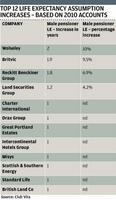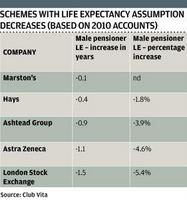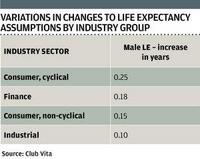Schemes such as Astra Zeneca and Reckitt Benckiser have made sizable changes to their life expectancy assumptions, but Owen Walker discovers small, frequent reviews are better to avoid the risk of poor data

A number of FTSE 350 defined benefit (DB) pension schemes have made large amendments to their life expectancy assumptions, their accounts have shown, while others have made no changes at all.
Schemes that do not alter their mortality assumptions run the risk of having data that is out of date.
This could impact their funding level and lead them to make inappropriate investments – ultimately putting members’ savings at risk.
“It could also impact schemes’ liability-driven investment cash flows, their funding level trigger points and also their risk transfer decisions,” said Andrew Gaches, a longevity consultant at Club Vita, which compiled the statistics.
Schemes are being advised to review their mortality assumptions annually and consider any changes in longevity trends.
This would ensure their assumptions are as accurate as possible and their funding level does not fluctuate wildly. This could also lead to higher Pension Protection Fund levy payments.
In response to rising longevity, more than half of the 118 DB schemes analysed – including Reckitt Benckiser and Land Securities – have increased their life expectancy assumptions.
Meanwhile, just five decreased them: Marston’s, Hays, Ashstead Group, Astra Zeneca and the London Stock Exchange scheme. The remaining 57 schemes made no change at all.
“There are a small number making relatively big changes and a large number of schemes making no changes,” Gaches said.
“That shows schemes are making infrequent big changes.”
Scheme experiences
Of the 61 schemes that have increased their life expectancy assumptions, 12 have increased them by one year or more.
 The pensions manager at one of these schemes said the decision was made following a recommendation from the scheme actuary.
The pensions manager at one of these schemes said the decision was made following a recommendation from the scheme actuary.
“The actuary came up with the recommendation and put it to the trustee board to approve,” he said. “I’m yet to come across a trustee board that didn’t take on the actuary’s recommendation.”
Schemes have been increasing their mortality assumptions in response to rising longevity.
Life expectancy is currently increasing at a rate of three months every year for a 65-year-old male, according to the Office for National statistics.
But a small number of other schemes have been reducing their mortality assumptions, as is shown in the table above.
Timely reviews
Gaches said there were many reasons why schemes would reduce their mortality assumptions, especially if their membership was concentrated in a particular region or demographic.
But he said the most important element for schemes to consider was to review their mortality assumptions regularly to ensure they were as accurate as possible.
“No one would dream of using out-of-date gilt yields to inform their assumptions – even if they were a week old,” he said. “So why would you consider doing it with longevity data?
“The old days of looking at longevity every three years are over. Even if you don’t  make a decision to change your assumptions, you should at least be looking at it frequently.”
make a decision to change your assumptions, you should at least be looking at it frequently.”
Often schemes do not consider their mortality assumptions annually because it is a low priority when compared with other factors.
But small movements in life expectancy assumptions can have large impacts on the scheme’s funding level.
The manager of the scheme that had increased its assumptions added: “You should listen to your actuary, but also pay regard to what the Pensions Regulator has to say on life expectancy assumptions.
“There is no point burying your head in the sand.”
The regulator published its guidance on mortality assumptions in September 2008, but it does not make any explicit statement on how frequently reviews should be conducted.
A spokesperson said a review of mortality assumptions was expected as part of schemes’ triennial reviews.
The regulator also expects additional reviews to be conducted following events that could impact life expectancy of the membership.






















